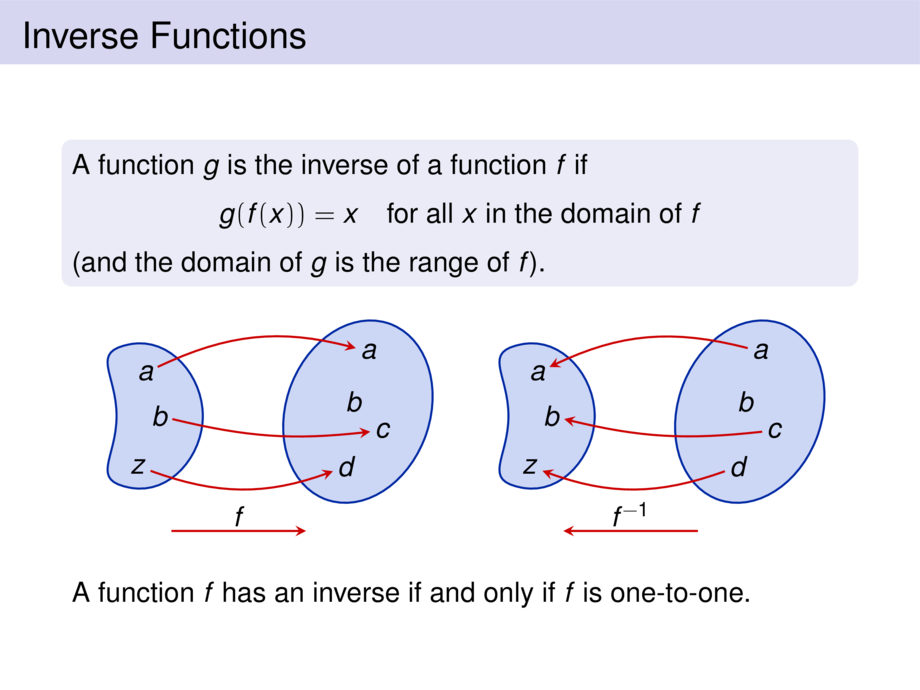



































































































200/353
\begin{frame}
\frametitle{Inverse Functions}
\begin{block}{}
A function $g$ is the inverse of a function $f$ if
\begin{talign}
g(f(x)) = x \quad \text{for all $x$ in the domain of $f$}
\end{talign}
(and the domain of $g$ is the range of $f$).
\end{block}
\pause\medskip
\begin{minipage}{.50\textwidth}
\begin{center}
\begin{tikzpicture}[default]
\draw [fill=cblue!20,draw=cdblue] (0cm,0cm) to[out=10,in=90] (1cm,-1cm) to[out=-90,in=-10] (0cm,-2cm) to[out=170,in=-90,looseness=1.5] (-.2cm,-1cm) to[out=90,in=190,looseness=1.5] (0,0);
\node (D) at (0,-2.6cm) {};
\node (x) at (.2cm,-.4cm) {$a$};
\node (a) at (.4cm,-1cm) {$b$};
\node (z) at (.1cm,-1.7cm) {$z$};
\begin{scope}[xshift=35mm]
\draw [fill=cblue!20,draw=cdblue,rotate=-20] (0cm,-1cm) ellipse (1cm and 1.3cm);
\node (E) at (-.5,-2.6cm) {};
\node (a') at (-.2cm,-.1cm) {$a$};
\node (c') at (-.4cm,-.8cm) {$b$};
\node (q') at (-.5cm,-1.7cm) {$d$};
\node (p') at (-0cm,-1.2cm) {$c$};
\end{scope}
\begin{scope}[cdred,->,>=stealth,thick]
\draw (x) to[bend left=20] (a');
\draw (a) to[bend left=-10] (p');
\draw (z) to[bend left=-20] (q');
\draw [shorten >= 5mm, shorten <= 5mm] (D) to node [above,black] {$f$} (E);
\end{scope}
\end{tikzpicture}
\end{center}
\end{minipage}
\begin{minipage}{.49\textwidth}
\begin{center}
\begin{tikzpicture}[default]
\draw [fill=cblue!20,draw=cdblue] (0cm,0cm) to[out=10,in=90] (1cm,-1cm) to[out=-90,in=-10] (0cm,-2cm) to[out=170,in=-90,looseness=1.5] (-.2cm,-1cm) to[out=90,in=190,looseness=1.5] (0,0);
\node (D) at (0,-2.6cm) {};
\node (x) at (.2cm,-.4cm) {$a$};
\node (a) at (.4cm,-1cm) {$b$};
\node (z) at (.1cm,-1.7cm) {$z$};
\begin{scope}[xshift=35mm]
\draw [fill=cblue!20,draw=cdblue,rotate=-20] (0cm,-1cm) ellipse (1cm and 1.3cm);
\node (E) at (-.5,-2.6cm) {};
\node (a') at (-.2cm,-.1cm) {$a$};
\node (c') at (-.4cm,-.8cm) {$b$};
\node (q') at (-.5cm,-1.7cm) {$d$};
\node (p') at (-0cm,-1.2cm) {$c$};
\end{scope}
\begin{scope}[cdred,<-,>=stealth,thick]
\draw (x) to[bend left=20] (a');
\draw (a) to[bend left=-10] (p');
\draw (z) to[bend left=-20] (q');
\draw [shorten >= 5mm, shorten <= 5mm] (D) to node [above,black] {$f^{-1}$} (E);
\end{scope}
\end{tikzpicture}
\end{center}
\end{minipage}
\pause\bigskip
A function $f$ has an inverse if and only if $f$ is one-to-one.
\end{frame}

